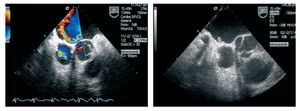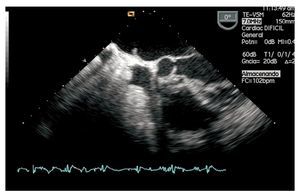A 54-year-old man with a medical history of diabetes, dyslipidemia, and abdominal aneurysm was seen for fever of 1 month's evolution with no attributable focus.
The physical examination was notable for high-pitched IV/VI systolic murmur at the mitral valve; the remaining examination was unremarkable. Laboratory findings included anemia (hemoglobin, 10.6), erythrocyte sedimentation rate, 80; and mildly elevated carcinoembryonic antigen (7.5). Hepatic lesions seen on ultrasound study and a positive blood culture for Streptococcus viridans suggested a diagnosis of fever with a tumor origin rather than endocarditis. Transthoracic echocardiography showed posterior mitral valve prolapse with severe regurgitation and no signs of vegetations. Transesophageal echocardiography revealed eversion of the posterior valve due to rupture of cords, with severe eccentric regurgitation toward the interatrial septum, where a 1-cm nodular image was visualized. Because of the atypical appearance of the mass, antibiotic therapy was delayed and the patient was kept in observation. At 8 days, fever reappeared and transesophageal echocardiography was repeated. The interatrial septal mass was seen to have grown in size (1´2 cm), which constitutes a definite sign of endocardial vegetation (Figure 1). Antibiotic treatment was initiated and S viridans infection was later confirmed in 3 positive blood cultures. The patient remained afebrile, stable, and asymptomatic. Magnetic resonance imaging confirmed that the hepatic lesions were benign (hemangiomas). At 1 month a new transesophageal echocardiography documented persistence of a fibrous interatrial lesion (Figure 2). The patient has remained asymptomatic. There are very few reported cases of endocarditis of the interatrial septum caused by injury from the mitral regurgitation jet.
Figure 1. Mitral jet on the interatrial septum and vegetation.
Figure 2. Residual fibrotic vegetation.




